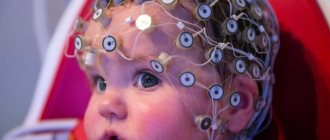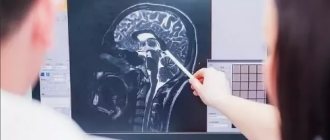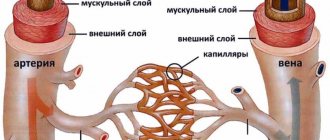Residual cerebral encephalopathy (RE) is a pathological condition caused by organic changes in cerebral structures against the background of ischemia, infections, injuries and other lesions. The severity ranges from minor impairments to severe neurological deficits that cause disability. The most common symptoms are headaches, paresis, autonomic dysfunction, and loss of consciousness. Intellectual and emotional disorders are possible.
To schedule a consultation, contact our operator by phone 8(969)060-93-93.
Causes
The etiology of EC in children and adults varies, but the underlying cause is always damage to brain tissue. In patients of younger age groups, the disease is most often associated with insufficient blood supply to the brain during gestation, during childbirth and in the first days after birth. The congenital form is provoked by factors such as intrauterine hypoxia, complications during childbirth, birth injuries, and the use of obstetric aids. Heredity, the presence of bad habits in the mother and the age of the pregnant woman play a certain role.
The list of factors that provoke RE in adult patients includes the following conditions:
- chemical dependencies: alcoholism, drug addiction;
- poisoning: salts of heavy metals, insecticides, other toxic substances, often as part of industrial hazards;
- radiation exposure;
- traumatic brain injuries;
- ischemic and hemorrhagic strokes, vascular thrombosis, hypertensive crises;
- cerebral atherosclerosis;
- infectious and inflammatory diseases of the membranes and tissues of the brain: meningitis, arachnoiditis, encephalitis;
- abnormalities in the development of brain structures and cerebral vessels;
- conditions after neurosurgical operations.
Determining the cause of the pathology is associated with some difficulties, since symptoms often appear many years after the adverse effect. In old age, the consequences of injury or infection may be superimposed by hypertension and atherosclerosis.
Treatment of residual form of the disease
You should know that currently the treatment of residual schizophrenia as a residual phenomenon (remission) after a mental disorder (paranoid, hebephrenic, catatonic, simple or other schizophrenic disease) is carried out using different methods, which depend on many factors. The symptoms and course of this disease depend, first of all, on the severity of the disorder, its form and its consequences.
The residual (residual) form of the disease as an independent diagnosis is not used so often, and its treatment comes down mainly to the social adaptation of patients and reducing the negative consequences of the mental disorder they have suffered. But, despite the fact that this form of the disease is considered relatively stable, different approaches to its diagnosis are still controversial, and the relevance of this problem today remains quite significant.
The specialists of our Center have significant experience in treating this mental condition and fixing positive symptoms, as well as adapting the patient to social and family life. The use of modern effective medications in combination with a course of psychotherapy, observation of the patient at all stages of the disease and remission, relief of residual symptoms - all these measures result in bringing the patient into a stable state, reducing the risks of developing negative symptoms of the disease and the need for hospitalization of the patient. This will ultimately make it possible to stop the disease and reduce the likelihood of the patient developing disability due to this disease.
Symptoms
Manifestations are characterized by significant variability, their nature and severity depend on the prevalence and severity of damage to nerve cells, the compensatory capabilities of the brain and the age of the patient. In infants, signs of encephalopathy of residual origin are increased or decreased muscle tone, unmotivated crying, lack of response to stimuli, or, conversely, frequent episodes of restlessness.
As the child grows, mental retardation, delayed speech development and motor skills are added to the listed symptoms. The presence of such manifestations with sufficient probability indicates the prospect of persistence of residual phenomena throughout life. It should be taken into account that the clinical picture does not always correlate with the severity of brain dysfunction; some signs disappear over time or are eliminated with the help of therapeutic measures.
Subsequently, residual phenomena such as emotional disorders and delayed psychomotor development come to the fore. Children sleep poorly and are characterized by increased tearfulness and irritability. Long-term consequences of perinatal residual organic encephalopathy may include insufficient control over one’s behavior, attacks of aggression, fainting, nausea, vomiting, headache, autonomic dysfunction, poor memory, and decreased learning ability.
Manifestations of the disease can be combined into several neurological syndromes:
- Intellectual-mnestic. Occurs with cognitive impairment, attention and memory disorders.
- Astheno-neurotic. Weakness, increased fatigue, emotional instability, depressive and hypochondriacal tendencies are noted.
- Vestibular-coordinating. Accompanied by dizziness and poor coordination of movements.
- Cephalgic. There are severe headaches.
In adolescent and adult patients, residual encephalopathy may manifest itself as follows:
- frequent migraines that are difficult to relieve with traditional methods;
- emotional lability: apathy, hypochondria, sudden mood swings, causeless crying, increased anxiety, attacks of aggression;
- intracranial hypertension, manifested by headaches, nausea and vomiting;
- autonomic dysfunction: instability of blood pressure, increased or decreased heart rate, sweating;
- insomnia: difficulty falling asleep, frequent awakenings, daytime sleepiness;
- in severe cases - convulsions.
Clinical manifestations of encephalopathy on a residual organic background range from minor to pronounced. In most cases, especially with congenital anomalies, traumatic or inflammatory genesis of the pathology, signs of increased intracranial pressure come to the fore.
A common symptom is persistent cephalgia, peaking in the morning. Characteristic symptoms include nausea and vomiting at the height of a painful attack, weakness, fatigue, blurred vision or spots before the eyes, and difficulty performing intellectual work. Half of the patients have vestibular disorders. Sometimes a decrease in the accuracy of small movements is detected.
Manifestations of residual encephalopathy
The symptoms of residual brain changes can be very diverse, and the degree of severity depends on the depth of brain damage and its compensatory capabilities, as well as the age of the patient. In children, signs that some changes in the central nervous system are likely to remain in the future can be noticeable literally from the first days or weeks of life.
Such signs often include convulsive twitching, constant restlessness or lack of response to stimuli, unmotivated crying, increased or decreased muscle tone, delayed motor and mental development, which most likely cannot be eliminated. At the same time, these signs are very subjective and do not always reflect the degree of brain dysfunction, so parents should not panic and specialists should not over-diagnose.
Symptoms of residual encephalopathy can fit into individual neurological syndromes:
- Cephalgic, manifested by intense headaches;
- Vestibular-coordinating, when motor skills and coordination are impaired, dizziness appears;
- Astheno-neurotic - with fatigue, severe weakness, hypochondria, a tendency to depression, emotional lability;
- Intellectual-mnestic disorders - decreased memory, attention, intelligence.
In children, the manifestations may differ somewhat from those listed, especially at an early age, but almost always signs of delayed psycho-motor development and disturbances in the emotional sphere come to the fore as residual phenomena. Young patients get tired quickly, are irritable and whiny, restless and sleep little.
The consequences of mild to moderate perinatal encephalopathy, which was compensated in the first year of life, can be:
- Attacks of aggression or loss of control over behavior and emotions;
- Reduced learning ability, poor school performance, memory disorders;
- Headaches, attacks of nausea and vomiting, fainting;
- Autonomic disorders - sweating, heart rate fluctuations, insomnia, etc.
These symptoms do not fit into a specific disease, such as epilepsy, so many neurologists tend to combine them under the concept of residual encephalopathy.
In adults, symptoms of residual encephalopathy may include:
- Persistent migraines that respond poorly to conservative treatment;
- Signs of intracranial hypertension - nausea, vomiting at the height of headache;
- Sleep disorders - insomnia at night, drowsiness during the day;
- Changes in memory and decrease in intellectual abilities, in severe cases - dementia;
- Emotional imbalance - frequent mood swings, irritability to the point of aggression, anxiety, crying for no reason, hypochondria or apathy;
- Autonomic symptoms - pressure surges, tachycardia or bradycardia, sweating, fluctuations in body temperature;
- In severe cases - convulsive syndrome of varying severity.
In a large proportion of cases of residual encephalopathy, especially if changes in the brain are caused by previous purulent inflammation of the meninges, trauma, or congenital defects, symptoms of increased intracranial pressure appear in the clinic. This is, first of all, a headache that gets worse in the morning, with nausea and vomiting, as well as “floaters” or blurred vision, general anxiety or severe weakness, fatigue and a decrease in the intellectual potential of the brain.
Approximately half of the patients complain of dizziness and the inability to maintain balance when walking, which indicates damage to the vestibular nerve centers. There may be difficulties with writing and making small precise movements.
In general, speaking about the symptoms of residual encephalopathy, it is impossible to identify signs characteristic of this particular pathology. Its manifestations are varied, as is the localization of lesions in the brain. Depending on the individual ability of the body to compensate for the existing defect, symptoms can range from barely noticeable to clearly expressed, but they rarely limit a person in normal daily life activities.
Diagnostics
The diagnosis is made by a neurologist. It is often associated with significant difficulties due to the significant period between the causative disease and the time of manifestation of residual encephalopathy. A thorough collection of anamnesis and complaints, a comprehensive laboratory and instrumental examination are necessary. The list of hardware techniques includes EEG, MRI and CT of the brain. According to indications, a spinal puncture is performed, and genetic tests are performed to exclude hereditary provoking pathologies.
Organic personality disorder
Organic personality disorder is a persistent disorder of the brain, as a result of its disease, damage or dysfunction, causing a significant change in the patient’s behavior, decreased mental functions, and mental exhaustion. Disorders appear in childhood and can manifest themselves throughout life. The course of the disease depends on age; the most dangerous periods are critical periods, for example, puberty, menopause. Moreover, in favorable conditions, stable compensation of the individual can occur while maintaining the ability to work, and in the event of negative influences (infectious diseases, organic disorders, emotional stress), decompensation may occur, in which psychopathic manifestations become pronounced.
In general, the disease is chronic; in many cases, the disease progresses, leading to complete social maladaptation, but with appropriate treatment it is possible to improve the patient’s condition. Very often, patients avoid treatment and do not recognize the fact of the disease. Symptoms and diagnosis
To diagnose the disease, the following research methods are used: EEG, MRI, psychological methods (MMPI, Rorschach test, thematic apperception test). An organic disorder of brain structures of various etiologies (disease, injury or brain dysfunction), the absence of disturbances of consciousness and memory and the manifestation of typical changes in the nature of behavior and speech are revealed.
But for a clear diagnosis, long-term, at least six months, observation of the patient is necessary. During this period, the patient must show at least three signs of an organic personality disorder. The signs are:
- Inability to carry out activities, especially long-term ones, requiring concentration and volitional efforts. Especially if the receipt of the result of the activity is delayed or something does not work out;
- Severe emotional instability, inability to self-control, large fluctuations in the expression of emotions, euphoria or complete apathy, uncontrolled manifestations of aggression, severe irritability;
- Disinhibition of base instincts. Ignoring social norms, stealing. Inappropriate sexual behavior.
- Neglect of personal hygiene, sometimes gluttony.
- The emergence of paranoid concepts, unnatural suspicion. Obsession with one abstract idea, for example, religious.
- Categorical assessments of other people's behavior; Obvious changes in speech (hypergraphia, viscosity);
- Changes in sexual preferences, sometimes hypersexuality.
Although memory changes are usually not observed in the initial stages of the disease, as the disease progresses, memory disorders may appear, and this allows us to talk about dementia.
Causes
Due to the large number of damaging factors, ranging from birth trauma to radiation, organic disorders are very common.
The main causes of disorders are:
Traumatic head injuries and repeated injuries, especially damage to the temporal or frontal lobe;
- Infectious lesions of the brain;
- Brain diseases (multiple sclerosis, tumor);
- Vascular diseases (subarachnoid hematomas);
- Cerebral palsy;
- Encephalitis with subsequent somatic disorders (postencephalic parkinsonism);
- Chronic manganese poisoning;
- Use of psychoactive substances (alcohol, stimulants, steroids, hallucinogens);
- Temporal lobe epilepsy.
In patients suffering from epilepsy for more than ten years, an organic personality disorder develops, and it is assumed that there is a relationship between the frequency of seizures and the degree of the disorder.
Despite the fact that organic personality disorders have been studied since the end of the century before last, the features of the formation and development of symptoms remain unclear to this day. There is no convincing data on the influence of biological and social factors on this process. Brain lesions of exogenous origin are considered as the main pathogenetic link, leading to a violation of the correct balance between the processes of excitation and inhibition in the brain. In recent years, an integrative approach to identifying the pathogenesis of mental disorders has been considered the most accurate. This approach involves the influence of the following factors: genetic, organic, socio-psychological. However, no significant analysis has been carried out on this issue. Much attention has always been paid to the study of organic disorders caused by traumatic brain injury, while disorders resulting from neuroinfections, vascular diseases, and intoxications still remain poorly studied.
Treatment
For treatment of a disorder to be effective, it must be comprehensive. A combination of psychotherapeutic and medicinal effects is necessary, which, when used skillfully, enhance each other’s effects.
Drug therapy involves the use of several types of drugs:
- anti-anxiety
- antidepressants
- nootropics
- hormones, lithium, anticonvulsants.
However, often drugs affect only the symptoms of the disease and after discontinuation of the drug the disease progresses again.
The main purpose of using psychotherapeutic methods is to alleviate the psychological state of the patient, help in overcoming depression, sexual problems, obsessive fears, and in learning new patterns of behavior. Help is provided for both mental and physical problems, in the form of a conversation or a series of exercises. Psychotherapeutic influence involves the use of group, individual, family therapy, which will allow the patient to build correct relationships with family members, and also provide him with emotional support from relatives. In addition, psychotherapy will allow family members to learn the rules of behavior and communication with the patient. The main effect, if possible, should be aimed at the organic cause of the disease. And of course, we need to strive to minimize harmful effects (alcohol). Most often, only patients with a severe course of the disease come to the attention of a psychiatrist, but placing a patient in a psychiatric hospital is not always necessary, only if he is dangerous to others or to himself. Prevention of organic disorders begins with adequate obstetric care and rehabilitation in the postnatal period. Proper upbringing in school and family is of great importance.
https://www.skalpil.ru/psixiatriya/
Cost of services
| CONSULTATIONS OF SPECIALISTS | |
| Initial consultation with a psychiatrist (60 min.) | 6,000 rub. |
| Repeated consultation | 5,000 rub. |
| Consultation with a psychiatrist-narcologist (60 min.) | 5,000 rub. |
| Consultation with a psychologist | 3,500 rub. |
| Consultation with Gromova E.V. (50 minutes) | 12,000 rub. |
| PSYCHOTHERAPY | |
| Psychotherapy (session) | 7,000 rub. |
| Psychotherapy (5 sessions) | 30,000 rub. |
| Psychotherapy (10 sessions) | 60,000 rub. |
| Group psychotherapy (3-7 people) | 3,500 rub. |
| Psychotherapy session with E.V. Gromova (50 minutes) | 12,000 rub. |
This list does not contain all prices for services provided by our clinic. The full price list can be found on the “Prices” , or by calling: 8(969)060-93-93. Initial consultation is FREE!
Treatment
Therapeutic measures must be comprehensive. Drug therapy is complemented by lifestyle correction. It is necessary to normalize the daily routine, alternating work and rest, sufficient time in the fresh air, and moderate physical activity. Physiotherapy and sanatorium-resort treatment are recommended, and sometimes psychotherapy is indicated. Medicines are prescribed taking into account the existing symptoms:
- cephalalgia: analgesics and NSAIDs;
- migraine: medications from the triptan group;
- dizziness: betaserc;
- insomnia, psychoemotional disorders: adaptogens, sleeping pills, antidepressants;
- intracranial hypertension: diuretics.
How to treat RE is determined individually. Patients are prescribed nootropics and nerometabolites. Children, along with symptomatic therapy, are given classes with a psychologist and a defectologist. The most important role is played by the participation of parents who support the baby and regularly work with him.
The forecast for the future is quite favorable. In most cases, with adequate complex therapy, it is possible to achieve the disappearance or significant reduction of symptoms. Patients lead normal lives: they study various professions, work, and build families. In severe cases, residual effects may persist, mainly headaches and autonomic disorders.
To make an appointment, just call tel. 8(969)060-93-93.
Diagnosis and treatment of residual encephalopathy
Because residual changes may appear many years after the nerve tissue is damaged, diagnosis can be difficult. This requires a thorough examination to rule out all possible other causes of brain dysfunction. The diagnosis of residual encephalopathy requires a scrupulous history and examination - CT brain, MRI, electroencephalography, sometimes lumbar puncture, biochemical blood test, cytogenetic study to exclude chromosomal pathology.
Treatment is prescribed symptomatically, based on the manifestations of the pathology:
- For cranialgia, analgesics and non-steroidal anti-inflammatory drugs are indicated - analgin, ibuprofen, nimesil, etc.
- Diagnosed migraine implies specific anti-migraine treatment with drugs from the triptan group - sumatriptan, amigrenin;
- Means for normalizing the psycho-emotional state and sleep - antidepressants, adaptogens (afobazole, adaptol, persen, melason, sonnate, etc.);
- To improve brain activity, nootropics and drugs that improve metabolism in nervous tissue are indicated - piracetam, fezam, glycine, cortexin, mildronate, etc.;
- For increased intracranial pressure - diuretics (diacarb, veroshpiron);
- To eliminate dizziness, betaserc and its analogues are indicated.
Residual encephalopathy must be treated comprehensively, prescribing not only medications, but also the correct regimen, rest, walks, and adequate physical activity. Sanatorium treatment and medicinal baths are useful; in some cases, patients need to work with a psychotherapist or psychologist.
Children with residual changes are prescribed symptomatic treatment; classes with speech pathologists and child psychologists are advisable. Help from parents who can support and help the child cope with learning and development difficulties is very important.
The prognosis for residual encephalopathy is usually favorable. With treatment, the symptoms gradually weaken and disappear completely, allowing the patient to lead a normal lifestyle, play sports, and work. In more complex cases, you have to put up with some unpleasant symptoms (vegetative dysfunction, headaches). Severe degrees of encephalopathy require a revision of the diagnosis and a different formulation, which will indicate the specific cause and, accordingly, the form of the pathology.










